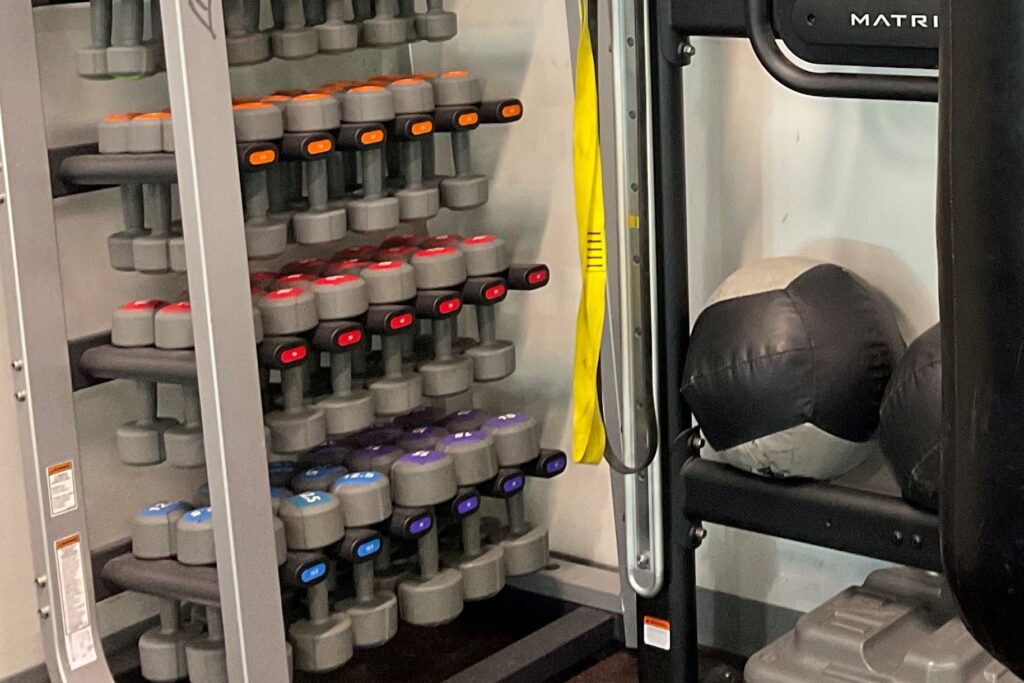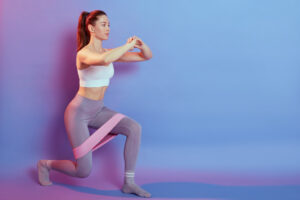Training your shoulders helps create a strong foundation for the rest of your upper body. Improved posture is one of the biggest bonuses of shoulder training, which can reduce back and neck pain, especially if you spend long hours sitting at a desk. Plus, strong shoulders can significantly enhance your performance in both sports and daily activities. By strengthening the stabilizer muscles around the shoulder joint, you’re also less likely to suffer from shoulder injuries, which are common in weightlifting and other physical activities.
This post will guide you through the best dumbbell exercises that target all areas of the shoulder, ensuring a balanced, well-rounded workout. Let’s dive in!
Best dumbbell shoulder exercises
Here are our favorites:
1. Dumbbell shoulder press
The dumbbell shoulder press is a compound movement, meaning it works multiple muscle groups at once, primarily targeting all three heads of the deltoid (front, middle, and rear).
How to do it:
- Sit or stand with a dumbbell in each hand, palms facing forward, and your arms at shoulder height.
- Press the dumbbells overhead until your arms are fully extended, but avoid locking your elbows.
- Slowly lower the dumbbells back to the starting position, maintaining control.
Form tips:
- Keep your core engaged to avoid arching your lower back.
- Lower the dumbbells to just below your ears to fully engage all three deltoid heads.
- Focus on controlled movement rather than swinging or jerking the weights up.
The shoulder press is essential for building overall shoulder mass and strength, but don’t go too heavy, especially if you’re just starting out. It’s easy to strain your neck or back if you let your form slip.
2. Lateral raise
If you want to create that coveted V-taper look, the lateral raise is your go-to move. This exercise isolates the medial (side) deltoid, which contributes to a wider, more rounded shoulder appearance.
How to do it:
- Stand with a dumbbell in each hand at your sides, palms facing in.
- With a slight bend in your elbows, lift the dumbbells out to the sides until your arms are parallel to the floor.
- Slowly lower the dumbbells back to the starting position.
Form tips:
- Focus on form over weight. It’s easy to cheat with momentum if you’re lifting too heavy.
- Avoid shrugging your shoulders or engaging your traps.
- Keep the movement slow and controlled to maximize tension on the medial deltoid.
While the lateral raise seems simple, it’s easy to make mistakes here. One of the most common errors is using too much weight and letting your traps or momentum do the work. Focus on light to moderate weight and maintain control throughout the movement.
3. Front raise
The front raise primarily targets the anterior (front) deltoid, which often gets plenty of indirect work during other compound exercises like the shoulder press or bench press. Still, it’s important to train this muscle directly for balanced shoulder development.
How to do it:
- Hold a dumbbell in each hand, palms facing your thighs.
- Raise one or both arms in front of you to shoulder height, keeping a slight bend in the elbow.
- Lower the dumbbells slowly back down.
Form tips:
- Don’t lift higher than shoulder level to protect the shoulder joint.
- Keep the movement smooth and controlled, avoiding any jerking motions.
- Engage your core to prevent swinging your body.
The front raise is great for adding definition to the front of the shoulders, but it’s crucial not to overdo it on the weight. Heavy weights can easily cause shoulder strain, so prioritize control and form instead.
4. Rear delt fly
The rear delt fly is a fantastic exercise for isolating the posterior (rear) delts, which are often neglected in many shoulder workouts. Strong rear delts help balance out the shoulder and contribute to better posture.
How to do it:
- Sit on a bench or stand with your torso bent forward at the hips, keeping your back flat.
- Hold a dumbbell in each hand with your arms hanging down and palms facing each other.
- With a slight bend in your elbows, raise the dumbbells out to the sides until they’re at shoulder height.
- Lower the dumbbells back down slowly.
Form tips:
- Keep your shoulders down and avoid shrugging.
- Squeeze your shoulder blades together at the top of the movement.
- Use light weights to maintain control and tension on the rear delts.
The rear delt fly helps correct shoulder imbalances, particularly if you’re someone who tends to neglect the back of the shoulders.
5. Arnold press
Named after the legendary Arnold Schwarzenegger, the Arnold press is a dynamic movement that targets all three heads of the deltoid. The key feature here is the rotational movement, which provides a more complete shoulder workout.
How to do it:
- Start with the dumbbells at shoulder height, palms facing your body.
- As you press the weights overhead, rotate your wrists so that your palms face forward at the top of the movement.
- Lower the dumbbells back down, reversing the wrist rotation.
Form tips:
- Keep the movement slow and controlled, especially during the rotation.
- Don’t over-rotate, as this can strain the shoulders.
- Engage your core to avoid leaning backward.
The Arnold press adds variety to your shoulder routine while ensuring all deltoid heads get involved. It’s a fantastic way to break up the monotony of traditional shoulder presses.
6. Dumbbell shrugs
While technically a trap exercise, shrugs are essential for shoulder stability and strength. The traps support the shoulder joint, and strong traps can improve your posture and reduce the risk of shoulder injuries.
How to do it:
- Stand with a dumbbell in each hand, arms at your sides.
- Shrug your shoulders up towards your ears, squeezing your traps at the top.
- Slowly lower the dumbbells back down.
Form tips:
- Avoid rotating your shoulders—just move straight up and down.
- Use moderate weights and focus on the squeeze at the top.
- Don’t overload the weight, as this can strain the neck and upper back.
7. Dumbbell upright row
The upright row works both the deltoids and the traps, making it a great compound movement for adding mass to your shoulders.
How to do it:
- Hold a dumbbell in each hand in front of your thighs, palms facing your body.
- Pull the dumbbells up towards your chin, keeping them close to your body.
- Lower the dumbbells back down slowly.
Form tips:
- Keep your elbows higher than your wrists during the movement.
- Avoid pulling too high, as this can lead to shoulder impingement.
- Keep the movement smooth and controlled.
The upright row can be tricky. It’s easy to go too heavy and end up with shoulder pain, so focus on using moderate weight and proper form to avoid injury.
Progressive overload for shoulder training
For shoulder training, consider adding weight in small increments, increasing the number of repetitions, or incorporating techniques like supersets (performing exercises back-to-back) or drop sets (reducing weight after reaching failure). Changing the tempo of your movements, such as slowing down the eccentric (lowering) phase, can also help create more tension and stimulate muscle growth.
The key is to keep pushing yourself, but always prioritize good form over heavier weights. Consistency and gradual progression will ensure you continue making gains without risking injury. Doing this exercises as part of a workout group is one way to stave off injury. Maximize your group workouts in South Congaree with these tips.
Final thoughts
By incorporating a range of exercises that target all three heads of the deltoid, you’ll develop balanced, well-rounded shoulders. Whether it’s the foundational shoulder press, the sculpting lateral raise, or the dynamic Arnold press, each exercise plays a key role in your shoulder workout. If you need more assistance, get in touch with our personal trainers in South Congaree.







